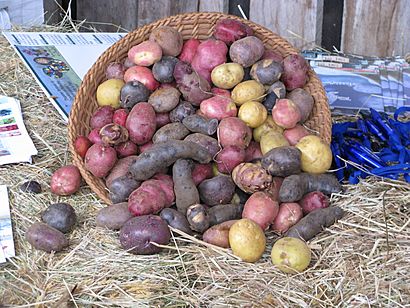Potatoes of Chiloé facts for kids
The Chiloé Archipelago in Chile is a special place for potatoes! It's one of the most important places in the world where many different types of potatoes come from. Only the Titicaca region in Peru and Bolivia has more variety.
Scientists and historians believe that the most common potato grown around the world today, called Solanum tuberosum tuberosum, first came from the Chiloé Archipelago. Local native people were growing these potatoes long before the Spanish arrived. Unlike potatoes from Peru and Bolivia, the potatoes from Chiloé are used to longer daylight hours, which is common in southern Chile.
After a big problem called the European Potato Failure in the 1840s, potatoes from Chiloé became very important. They replaced many of the older potato types from Peru that were grown in Europe.
The potatoes of Chiloé are also a big part of the local culture. They are used in Chilote folk medicine and even appear in Chilote mythology.
Contents
Amazing Potato Varieties of Chiloé
Historians and botanists have found about 300 different names for potatoes grown in Chiloé over time. Some of these unique local types include Bruja morada, Camota, Chochoca, Clavela lisa, Güencha, Pachacoña, Caballera, Cabrita, Cabra, Michuñe Azul, Michuñe negra, Michuñe roja, Huicaña, and Viscocha. Each of these has its own special look and taste!
Sometimes, new potato types from other countries have been brought to Chiloé. However, not all of them have grown well there, even if they were supposed to produce a lot of potatoes. For example, a type called coraíla was popular in the mid-1900s. But people stopped growing it when a plant disease called potato blight kept attacking it in the 1950s and 1960s.
Saving Chiloé's Potatoes
People started working to save these many special potato types in the 1960s. A plant expert named Andrés Contreras traveled all around the Chiloé Archipelago. He looked for small gardens where older women had been growing these traditional potatoes for many generations.
Today, the Austral University of Chile in Valdivia has a special place called a gene bank. This bank stores seeds and parts of many different Chiloé potato varieties. This helps make sure these unique potatoes will be around for a long time.
Wild Potatoes in Guaitecas
Some of the potatoes found in Chiloé also grow in the wild in the Guaitecas Archipelago. It's not completely clear how or when these wild potatoes first got there. We know that people were growing potatoes in Guaitecas before Christopher Columbus arrived in the Americas. A Spanish group even wrote about finding potatoes being grown there in 1557.
Later, during the second voyage of HMS Beagle, the famous scientist Charles Darwin collected wild potatoes from Guaitecas. These wild potatoes often grow near the sea in grassy areas. They mostly grow in the western part of the archipelago. Interestingly, these wild potatoes don't seem to grow from seeds very often. They also rarely produce flowers or fruits. They usually grow in places that are disturbed, like the coastal areas affected by winter storms.
Images for kids
See also
 In Spanish: Papa chilota para niños
In Spanish: Papa chilota para niños





